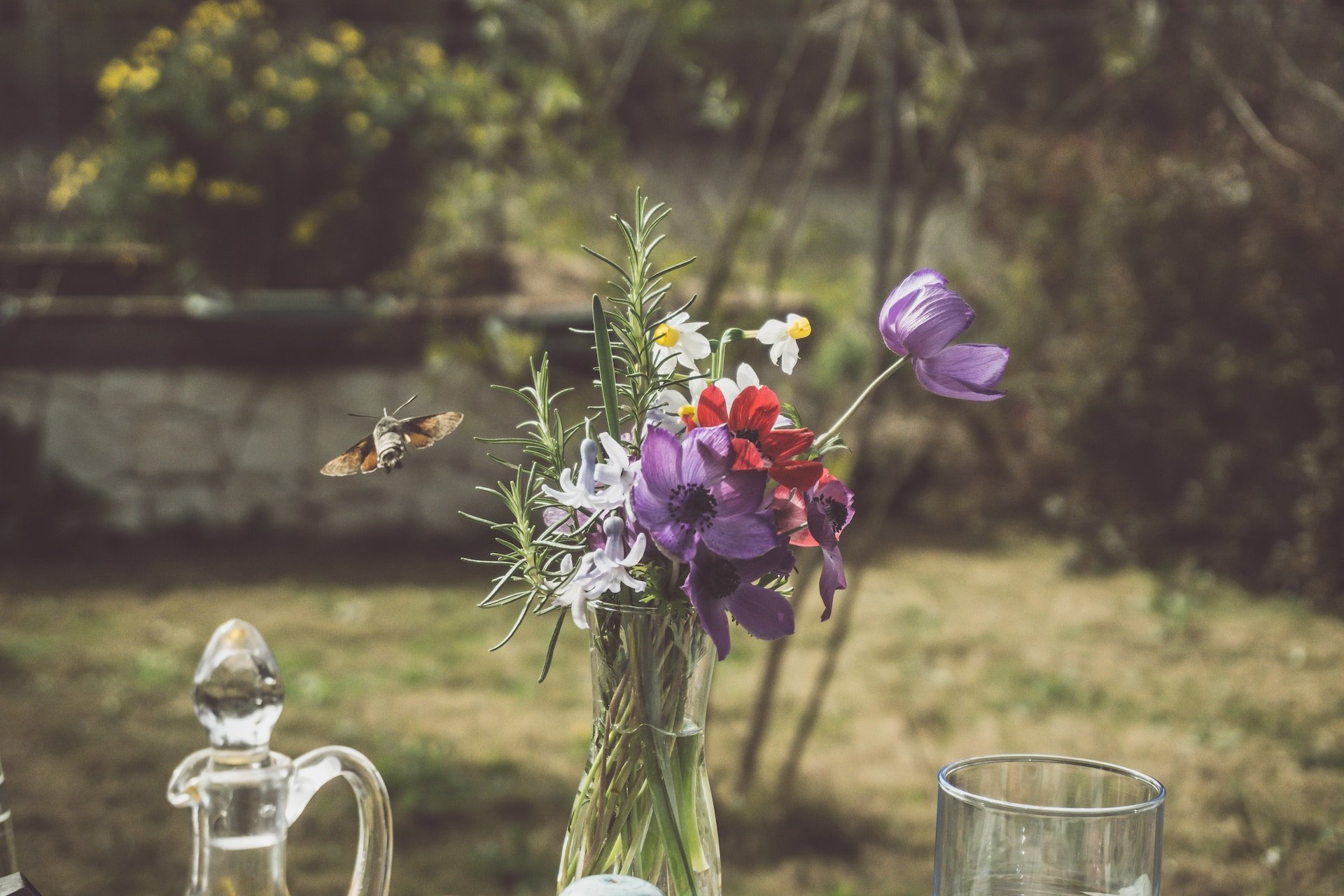Picture this: a lush, thriving garden teeming with vibrantly colored flowers and plump, delicious fruits and vegetables. But wait — what’s that lurking in the shadows? Pests, ready to wreak havoc on your carefully cultivated paradise. Fear not, for there are tiny heroes waiting in the wings, ready to defend your garden from these uninvited guests — enter the fascinating world of beneficial insects, nature’s very own pest control squad!
In this article, we delve into the enchanting realm of these miniature guardians and explore how they work tirelessly to protect our gardens from harmful pests. We’ll uncover the secret lives of predatory and parasitic insects and show you how to invite them into your green sanctuary.
So, without further ado, let’s embark on a journey to discover the untapped potential of beneficial insects — an essential component in transforming your garden into a thriving, self-sustaining oasis. As we unravel the mysteries behind these tiny warriors, you’ll soon realize that sometimes, the best things truly do come in small packages.
Benefits of Natural Pest Control
Utilizing beneficial insects as natural pest control offers several advantages over chemical pesticides.
For starters, they’re eco-friendly, helping to maintain a healthy balance within your garden’s ecosystem. They target specific pests without harming other beneficial organisms or plants, minimizing collateral damage.
Plus, they’re a cost-effective solution in the long run as they reproduce and multiply, forming a sustainable defense against future infestations.
Furthermore, natural pest control helps reduce our reliance on synthetic chemicals and their harmful effects on the environment. Pesticides can contaminate soil, water, and air, leading to negative consequences for both flora and fauna.
By encouraging the presence of beneficial insects in your garden, you’re not only protecting your plants but also promoting biodiversity.
In addition to being environmentally friendly, using beneficial insects as a form of pest control is also safer for you and your family. Chemical pesticides can pose health risks if ingested or improperly handled. Natural methods eliminate these concerns while still providing effective protection for your garden.
Another practical benefit of using beneficial insects is the potential for fewer outbreaks of pests resistant to chemical pesticides. Over time, many pests develop resistance to synthetic chemicals, rendering them less effective. In contrast, beneficial insects adapt alongside the pests they prey upon, ensuring continued effectiveness in controlling garden invaders.
Natural pest control also fosters a more resilient garden ecosystem by supporting various species’ interdependence. A diverse mix of plants and insects creates a robust web of life that is better equipped to withstand environmental challenges such as droughts or disease outbreaks.
All in all, incorporating beneficial insects into your gardening strategy can be an educational and engaging experience. Observing these remarkable creatures in action can provide valuable insights into nature’s intricate workings and encourage a deeper appreciation for the interconnectedness of all living things.
What Are Beneficial Bugs?
In the realm of gardening, not all insects are foes. In fact, many can be your greatest allies in the fight against common pests.
Beneficial insects can be broadly categorized into three groups: pollinators, predators, and parasites. We explore these categories and their most renowned representatives in greater detail in our separate article dedicated to beneficial insects. Make sure to give it a read before you move on to the next section!
Related: The Good, the Bugs, and the Bountiful: A Guide to Beneficial Insects in Your Garden
In terms of natural pest control, we’re interested in predatory and parasitic insects — tiny warriors from these two categories have evolved unique strategies to hunt down and eliminate a wide array of garden nuisances, working diligently to keep your plants safe and healthy.
By understanding their remarkable abilities and roles within the ecosystem, you can harness their potential to create a thriving, pest-free garden.
Predators
Predatory insects are voracious hunters that actively seek out and devour their prey. They play a crucial role in controlling pest populations by keeping them in check through direct predation.
While they may appear small and fragile, predatory insects possess specialized adaptations, such as sharp mandibles or lightning-fast reflexes, that make them formidable hunters.
Ladybugs

| Facts | Food: | Attracted To: |
| Ladybugs can consume up to 50-60 aphids per day. They undergo complete metamorphosis, with their larvae being equally hungry predators. | aphids, mites, fleas, Colorado potato beetle, scale insects. | dill, fennel, dandelion, marigolds, yarrow, calendula. |
Green Lacewings
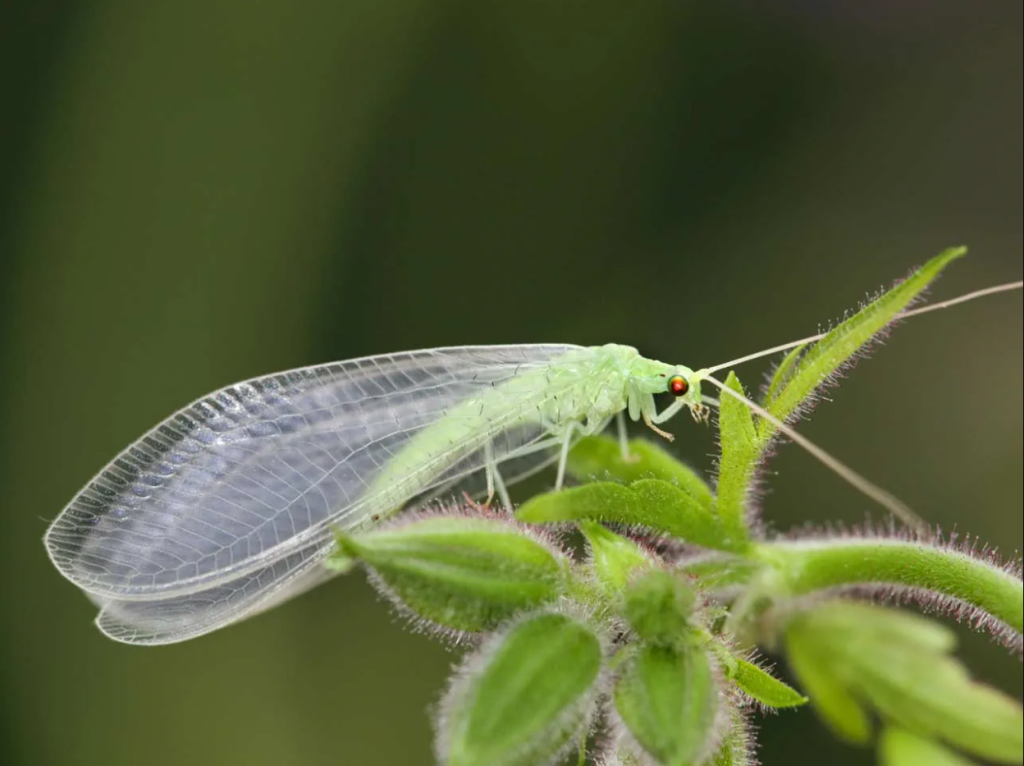
| Facts | Food: | Attracted To: |
| Often called “aphid lions” due to their voracious appetites. Can consume over 200 aphids per week during their larval stage, which is responsible for the actual job of getting rid of soft-bodied pests. | aphids, whiteflies, thrips, leafhoppers, mealybugs, small caterpillars | cosmos, sweet alyssum, angelica, dill, dandelion, coriander, coreopsis. |
Ground Beetles
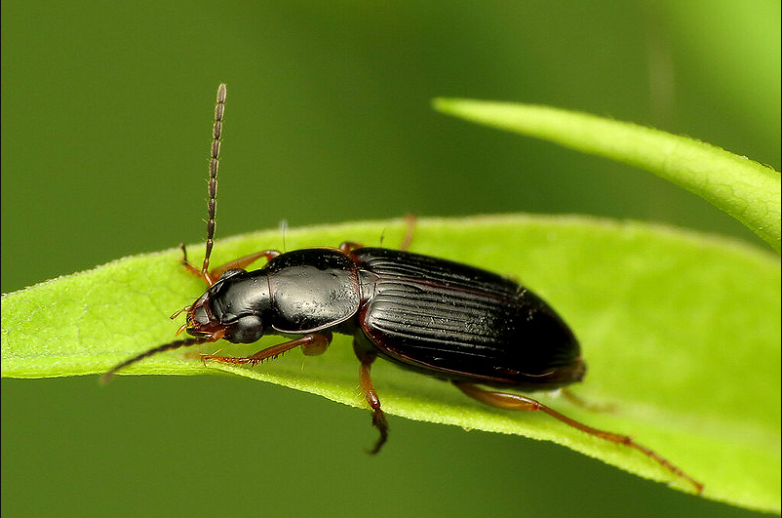
| Facts | Food: | Attracted To: |
| With over 2,500 species found in North America alone, they’re a diverse group of beneficial predators. Ground beetles are typically only active at night. | slugs, snails, cutworms, caterpillars, ants, other soil-dwelling pests. | evening primrose, amaranthus, clover, perennials & groundcovers that provide shelter. |
You can also attract ground beetles by mulching your garden to create a moist environment.
Praying Mantises
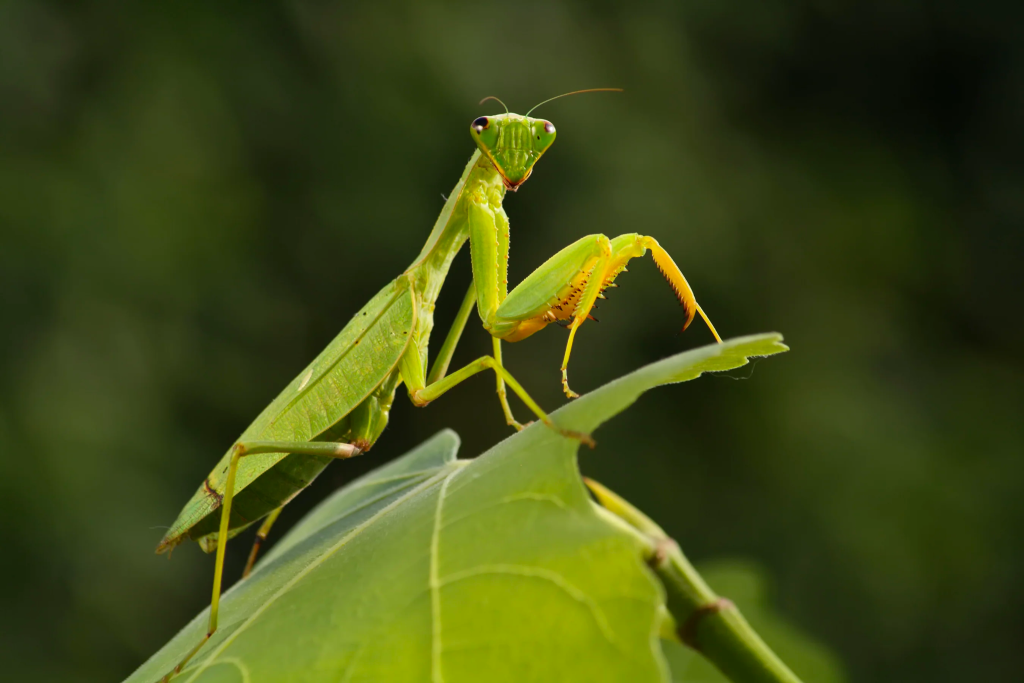
| Facts | Food: | Attracted To: |
| These stealthy predators are famous for their elongated bodies and folded forelegs used to capture prey. Mantises can turn their heads 180 degrees to view their surroundings. | beetles, caterpillars, grasshoppers, moths, gnats, crickets, even small rodents. | tall grasses, shrubs, cosmos, marigolds, dills, perennial plants that offer ample hunting opportunities. |
Related: Bugs That Look Like Grasshoppers But Fly
Spiders
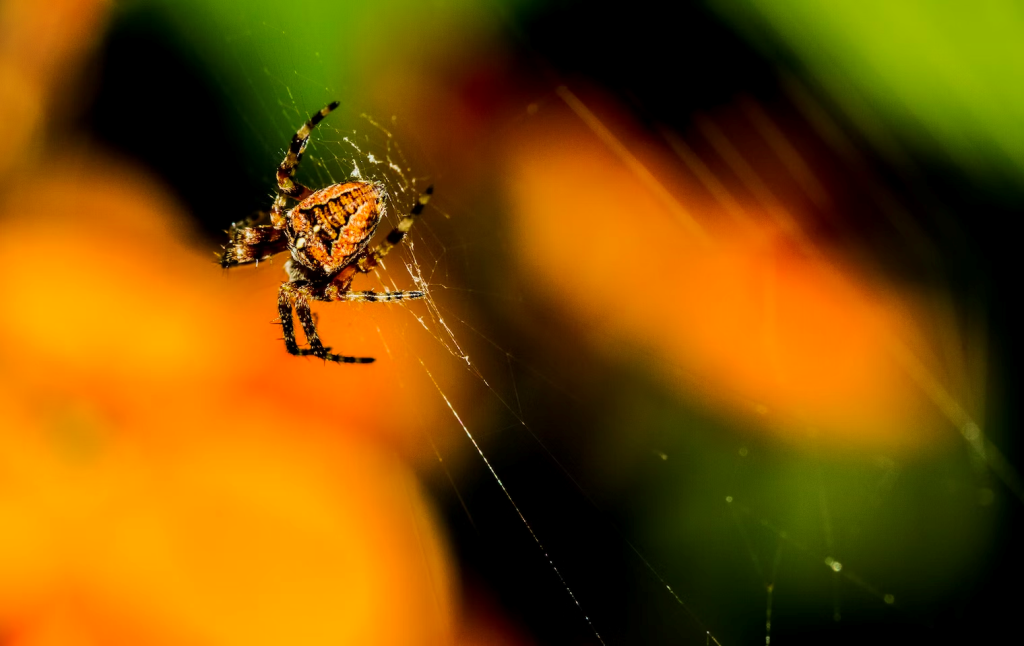
| Facts | Food: | Attracted To: |
| While not insects, spiders are critical allies in pest control. They employ various hunting strategies like spinning webs or actively stalking their prey to trap and consume numerous unwanted visitors | fruit flies, mosquitoes, small moths, bed bugs, aphids, roaches, grasshoppers. | Diverse plantings that create habitats, such as: shrubs, groundcovers, tall grasses. |
Assassin Bugs

| Facts | Food: | Attracted To: |
| True to their name, these fierce hunters use their long, needle-like mouthparts to pierce and inject lethal saliva into their prey. | aphids, caterpillars, leafhoppers. | Planting members of the Apiaceae family, including: dill, parsley, fennel. |
Hoverflies

| Facts | Food: | Attracted To: |
| Also known as syrphid flies or flower flies, hoverfly larvae are voracious predators of soft-bodied pests. Adult hoverflies feed on nectar and pollen, making them important pollinators. | aphids, scale insects, caterpillars. | yarrow, cilantro, statice, zinnias. |
By attracting these natural predators to your garden, you’ll have a built-in defense system working tirelessly to protect your plants from harm.
Parasites
Parasitic insects take a more covert approach to pest control. Rather than directly consuming their prey, these insects lay their eggs on or inside the bodies of host pests. Once the eggs hatch, the larvae feed on the host, eventually leading to its demise.
This method of biological control is highly effective, as it disrupts the reproductive cycle of pests and prevents future generations from causing further damage to your garden.
Braconid Wasps

| Facts | Food: | Attracted To: |
| Female braconid wasps lay their eggs inside the host caterpillars, and upon hatching, the larvae feed on the host’s internal tissues, eventually killing them. | tobacco hornworm, tomato hornworm, cabbage worms, caterpillars, aphids. | dill, parsley, yarrow, lemon balm. |
Trichogramma Wasps

| Facts | Food: | Attracted To: |
| Among the smallest insects in the world, these minuscule wasps parasitize the eggs of over 200 different pests. By preventing pest larvae from hatching, they halt infestations before they can start. Each Trichogramma female can parasitize about 100 host eggs. | moths, worms, butterflies. | Flowering plants like: goldenrod, marigold, zinnias. |
Ichneumon Wasps

| Facts | Food: | Attracted To: |
| These parasitic wasps are known for their long ovipositors, which they use to lay eggs inside the larvae or pupae of various pest species. The hatched larvae then consume the host from within. | caterpillars, beetles, wood-boring insects. | fennel, dill, wild carrot. |
Related: What Are Wasps Good For?
Tachinid Flies

| Facts | Food: | Attracted To: |
| Similar to braconid wasps, tachinid flies employ a parasitic strategy to control pest populations. They lay their eggs on various pests. Once the larvae hatch, they burrow into the host and devour it from within. | caterpillars, gypsy moths, beetles, true bugs. | dill, carrot, sweet clover, asters, angelica, buckwheat, yarrow. |
Aphid Midges

| Facts | Food: | Attracted To: |
| The larvae of aphid midges (Aphidoletes aphidimyza) are efficient predators of over 60 species of aphids. They inject a paralyzing toxin into aphids before devouring them. | aphids. | dill, plants with plenty of pollen and nectar (dandelion, asters, sweet alyssum, etc.), sources of water. |
Nematodes

| Facts | Food: | Attracted To: |
| Beneficial nematodes are microscopic worms that infest and kill soil-dwelling pests. Some species also target pests above ground, such as armyworms and fungus gnats. | grubs, borers, thrips, beetles rootworms, cutworms. | tomato, pepper, cucumber, squash, eggplant, okra. |
You should also water your garden thoroughly to create an inviting environment for nematodes, and consider adding organic matter like compost or aged manure to improve soil health.
By fostering an environment that attracts parasitic insects, you’ll benefit from their discrete yet powerful impact on unwanted garden visitors.
Before You Introduce Beneficial Insects
Before you unleash these heroes upon your garden, it’s essential to consider a few factors to ensure their success in protecting your plants and maintaining ecological balance.
- Research local regulations and permits. Before introducing non-native species into your area, familiarize yourself with any regulations, permits, or restrictions that may apply. Releasing non-native insects can cause unintended consequences, such as harming native ecosystems or disrupting the natural predator-prey balance. Consult with local gardening groups, extension offices, or environmental organizations for guidance.
- Communicate with neighbors. Talk to nearby gardeners about your plans to introduce beneficial insects. They might be using chemical pesticides that could inadvertently kill off your new allies or vice versa. Open communication promotes cooperation and enables everyone to adopt eco-friendly practices that support beneficial insect populations in the neighborhood.
- Monitor pest populations. Before introducing beneficial insects, assess the extent of your pest problem. This will help you determine which beneficial species to introduce and gauge their success in controlling pests over time. Regular monitoring also helps identify any new infestations that may require additional intervention.
How to Attract Beneficial Insects
Attracting beneficial insects to your garden involves creating a welcoming environment that caters to their needs.
Here are a few quick tips that will help you attract beneficial insects to your garden:
- Plant a diverse array of native flowers, herbs, and vegetables to support various insects’ preferences. Aim for a mix of shapes, sizes, and colors to ensure year-round blooms that offer nectar and pollen.
- Utilize the principles of companion planting by grouping plants that benefit each other. Certain plants can attract beneficial insects, while others may repel pests or provide habitat for predators.
- Provide water sources like shallow dishes or birdbaths, and leave some undisturbed areas where insects can take refuge.
- Avoid using chemical pesticides, as they might inadvertently harm your beneficial insect population. Instead, opt for organic or targeted treatments when addressing specific pest issues.
- Leave some undisturbed areas where insects can take refuge, such as grassy patches, brush piles, or rock walls, in order to create shelter for insects. This provides them with safe places to hide, overwinter, and lay eggs.
- Construct simple insect hotels using materials like hollow bamboo stems, drilled wood blocks, or bundles of twigs. These structures provide nesting sites for various beneficial insects like solitary bees and parasitic wasps.
- Healthy plants are more resistant to pests and diseases. Regularly weed, water, and fertilize your plants according to their specific needs.
- Many insects are attracted to or repelled by artificial light. Minimize or adjust outdoor lighting to avoid disrupting the natural behavior of beneficial insects.
- Be patient. Keep in mind that it may take some time for beneficial insect populations to establish themselves and effectively control pests in your garden.
By implementing these practical steps, you can create a thriving garden ecosystem that attracts and sustains beneficial insects. In turn, these tiny allies will help protect your plants from pests and contribute to a healthier, more balanced environment.
To further educate yourself on the subject, make sure to check our article specifically dedicated to attracting beneficial insects to gardens.
Related article: Natural Pest Control: 7 Ways to Attract Beneficial Insects to Your Garden
Conclusion
Embracing the power of beneficial insects in your garden is a smart, eco-friendly approach to pest control that yields long-term rewards.
By following the practical tips outlined in this article, you can create a thriving garden ecosystem that supports these natural predators and parasites while reducing your reliance on harmful chemicals.
The result? Healthier plants, a more diverse and balanced environment, and an increased appreciation for the fascinating world of insects and their role in sustaining our gardens.
So, go ahead and roll out the welcome mat for these tiny warriors — together, you’ll transform your garden into a flourishing oasis that truly embodies the beauty and resilience of nature!
Was it helpful?

Enamored with the world of golf Jack pursued a degree in Golf Course Management at THE Ohio State University. This career path allowed him to work on some of the highest profile golf courses in the country! Due to the pandemic, Jack began Inside The Yard as a side hustle that quickly became his main hustle. Since starting the company, Jack has relocated to a homestead in Central Arkansas where he and his wife raise cattle and two little girls.

